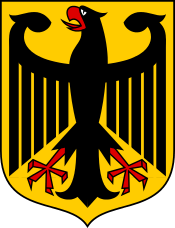German federal election, 1877
| | ||||||||||||||||||||||||||||||||||||||||||||||||||||||||||||||||||||||||||||||||||||||||||||||||||||||||||||||||||||||||||
| ||||||||||||||||||||||||||||||||||||||||||||||||||||||||||||||||||||||||||||||||||||||||||||||||||||||||||||||||||||||||||
| ||||||||||||||||||||||||||||||||||||||||||||||||||||||||||||||||||||||||||||||||||||||||||||||||||||||||||||||||||||||||||
 |
| This article is part of a series on the politics and government of Germany |
|
Constitution ("Fundamental Law Code") |
|
| Foreign relations |
Federal elections were held in Germany on 10 January 1877.[1] The National Liberal Party remained the largest party in the Reichstag, with 128 of the 397 seats.[2] Voter turnout was 61.6%.[1]
Results
| Party | Votes[a] | % | Seats | +/– |
|---|---|---|---|---|
| National Liberal Party | 1,470,000 | 27.2 | 128 | −27 |
| Centre Party | 1,341,300 | 24.8 | 93 | +2 |
| German Conservative Party | 526,000 | 9.8 | 40 | +18 |
| Social Democratic Party | 493,300 | 9.1 | 12 | +3 |
| German Reich Party | 426,600 | 7.9 | 38 | +5 |
| German Progress Party | 417,800 | 7.8 | 35 | −14 |
| Polish Party | 216,200 | 4.0 | 14 | 0 |
| Alsace-Lorraine Party | 200,000 | 3.7 | 15 | 0 |
| Liberal Union | 135,000 | 2.5 | 13 | New |
| German-Hanoverian Party | 85,000 | 1.6 | 4 | 0 |
| German People's Party | 44,900 | 0.8 | 4 | +3 |
| Danish Party | 23,000 | 0.4 | 1 | 0 |
| Others | 22,000 | 0.4 | 0 | 0 |
| Invalid/blank votes | 21,600 | – | – | – |
| Total | 5,422,600 | 100 | 397 | 0 |
| Registered voters/turnout | 8,943,000 | 61.6 | – | – |
| Source: Nohlen & Stöver, DGDB | ||||
a Figures for votes are rounded to the nearest 100.[1]
References
This article is issued from Wikipedia - version of the 3/12/2014. The text is available under the Creative Commons Attribution/Share Alike but additional terms may apply for the media files.